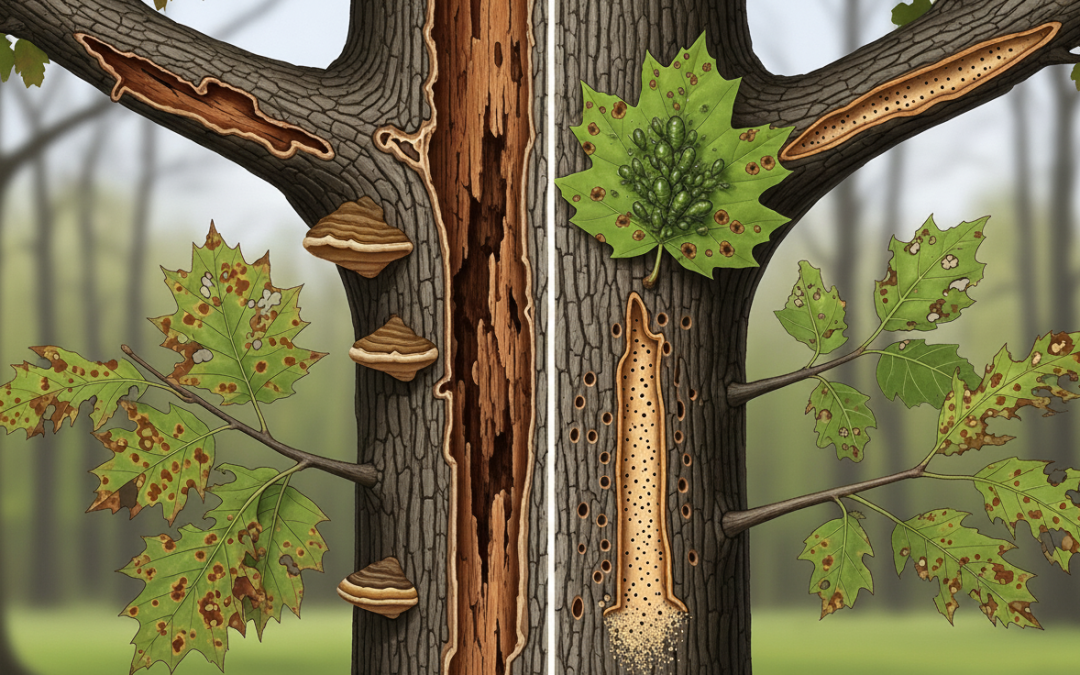Introduction: Your Tree’s Hidden Enemies
Trees, the magnificent elements of our gardens, are perpetually combating microscopic and insect threats. Although you have perfected the art of pruning and trimming, understanding how to identify and address pests and diseases is the next crucial step in becoming a genuine steward of your landscape. Early detection is vital—frequently, the initial indication of an issue is subtle, such as a slight discoloration or a sticky residue.
Section 1: The Three Warning Signs You Can’t Ignore
This section emphasizes easily identifiable symptoms that indicate a more serious issue, setting it apart from general tree decline (which you have already discussed).
- Leaf Discoloration and Drop: Beyond seasonal variations, be on the lookout for cankers (depressed, dead patches on the bark), leaf spots (dark brown or black lesions), or unexpected yellowing or browning that begins at the leaf tips.
- Unusual Growths: Be vigilant for fungal conks (mushroom-like structures) emerging from the trunk, which suggest internal rot, or peculiar, twisted branch tips referred to as witches’ brooms.
- Sticky Residue and Sooty Mold: If you notice a sticky substance on leaves or items beneath the tree, it is likely honeydew, a byproduct of sap-sucking insects such as aphids or scale, which subsequently promotes the growth of black sooty mold.
Section 2: The Most Wanted Pests in Malaysian Gardens
Concentrate on prevalent regional pests and the specific damage they inflict.
- Termites: (Particularly significant in Malaysia). They primarily target deadwood but may invade healthy trees if the bark sustains damage. Tip: Use a screwdriver to probe the base of the tree to listen for hollow sounds.
- Aphids and Scale Insects: These sap-sucking pests tend to cluster on new growth or along stems, extracting sap. Their presence is typically indicated by the sticky substance known as honeydew.
- Borers (Beetles): The most perilous of pests. They create tunnels beneath the bark. Look for small, perfectly round exit holes and fine sawdust (frass) located near the base of the tree. Once a borer infestation takes hold, it can lead to the tree being fatally girdled.
Section 3: Practical, Eco-Friendly Treatment Strategies
Prioritize non-chemical and low-impact solutions initially, in accordance with the “Eco-Friendly Garden” theme established in your previous posts.
1. Mechanical Removal/Pruning:
- For localized problems (such as a few branches infested with aphids or a diseased limb), the most effective remedy is typically sanitation. Trim the affected area and promptly bag or incinerate the waste.
- For minor pests, a powerful stream of water from a hose can dislodge them.
2. Biological and Natural Sprays:
- Neem Oil: This organic pesticide interferes with the life cycle of various insects (including aphids, scale, and mites) and serves as a fungicide.
- Insecticidal Soap: A precise solution for soft-bodied insects, reducing the risk to beneficial insects.
3. Soil and Tree Health: Emphasize that a robust tree inherently withstands pests. Ensure appropriate mulching (steering clear of “volcano mulching” against the trunk) and adequate watering to alleviate tree stress.
Conclusion: Prevention is the Best Medicine
Emphasize that the most effective protection against tree pests and diseases is constant vigilance and proactive maintenance. By routinely examining your trees and responding promptly, you not only preserve the health of the tree but also conserve your time and financial resources. If you are uncertain, it is advisable to consult a professional arborist—particularly for hazardous pests such as borers or extensive fungal infections.

